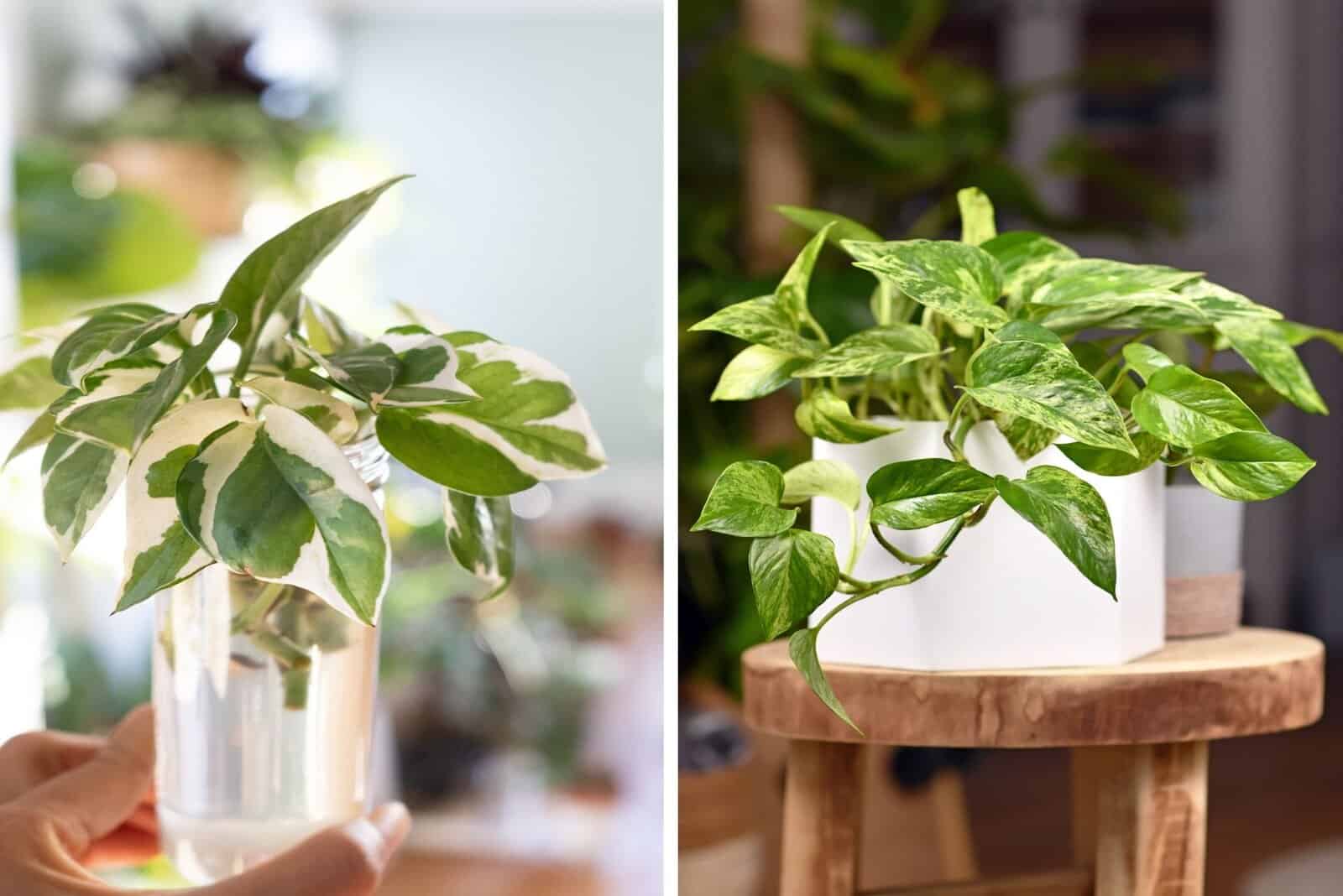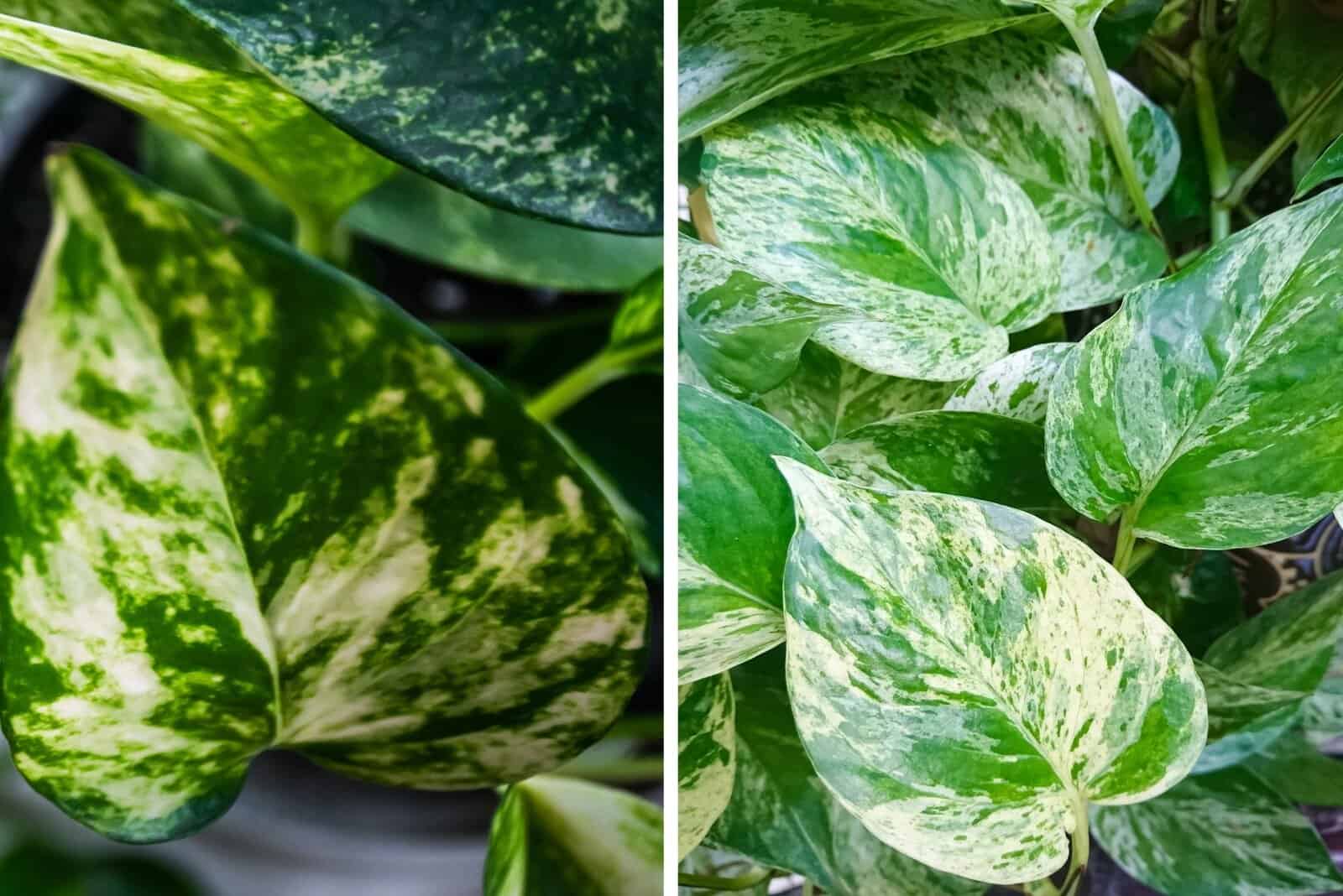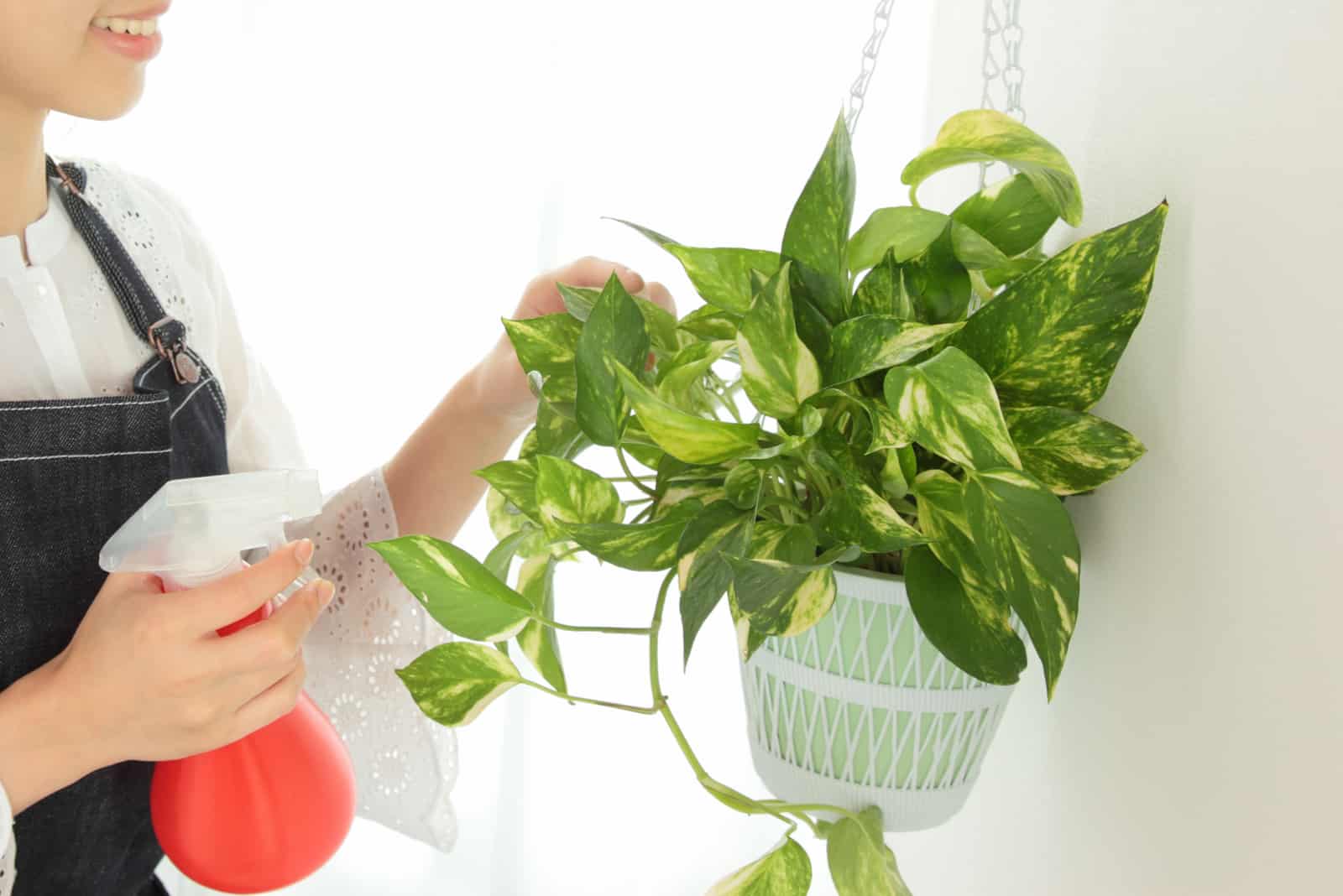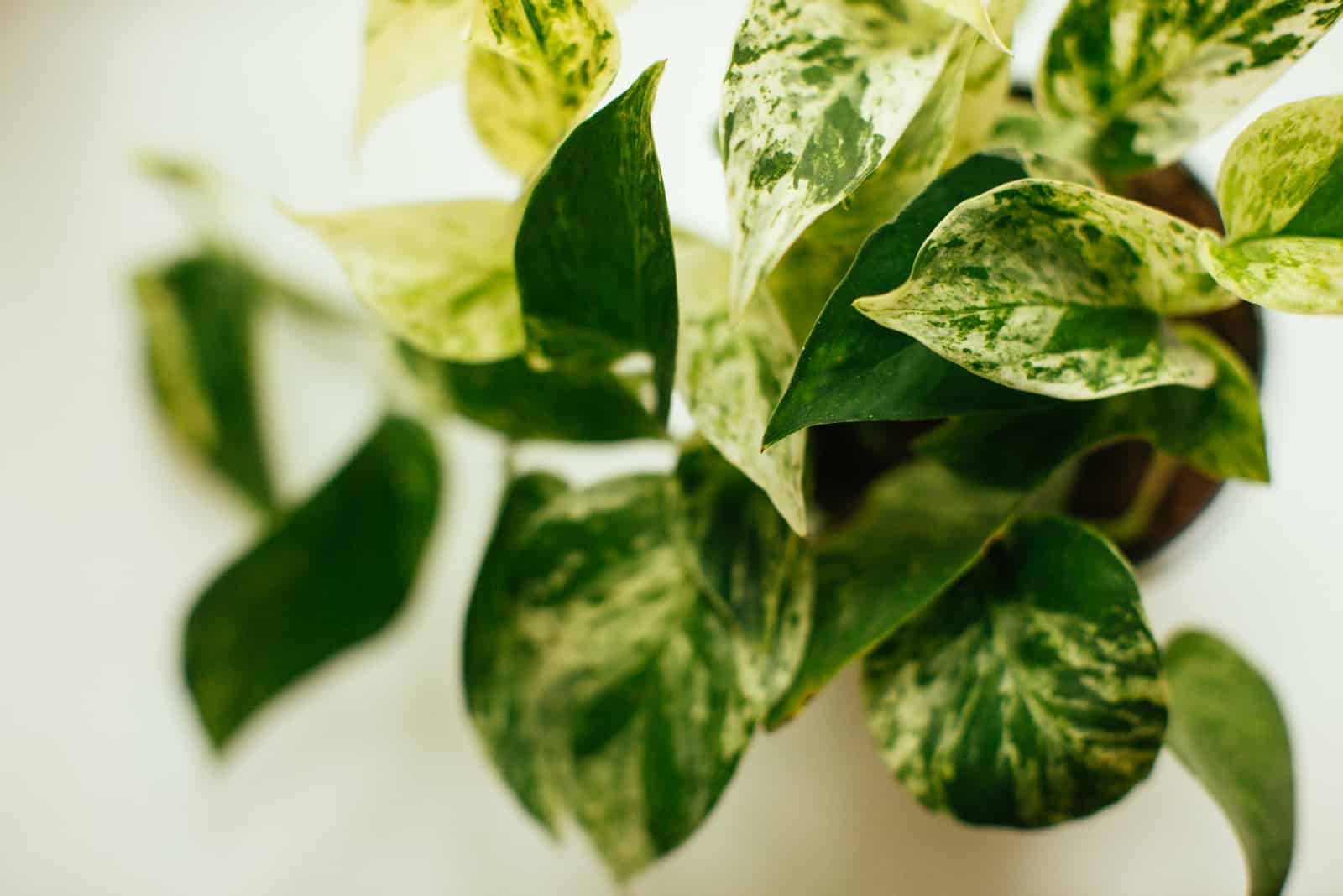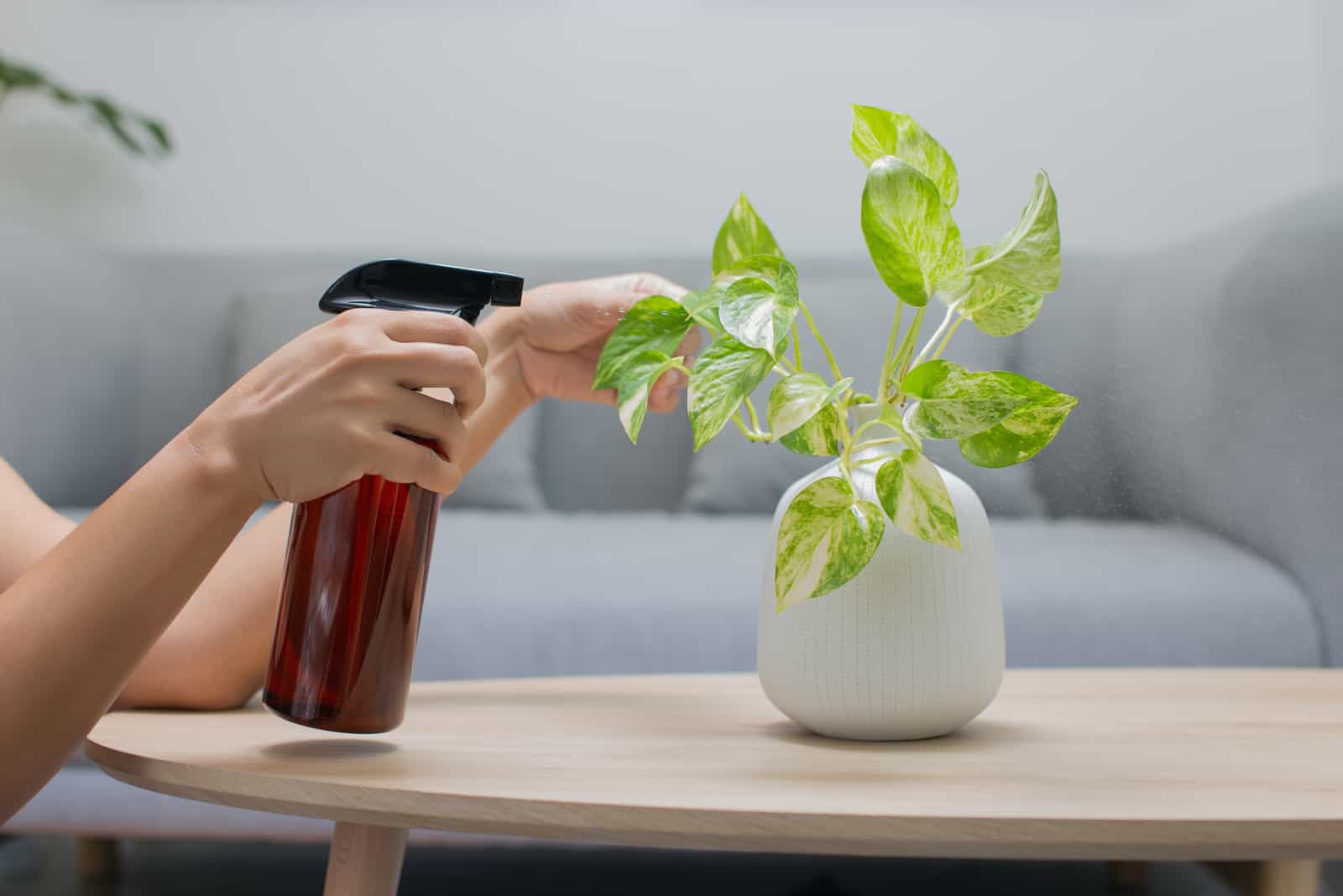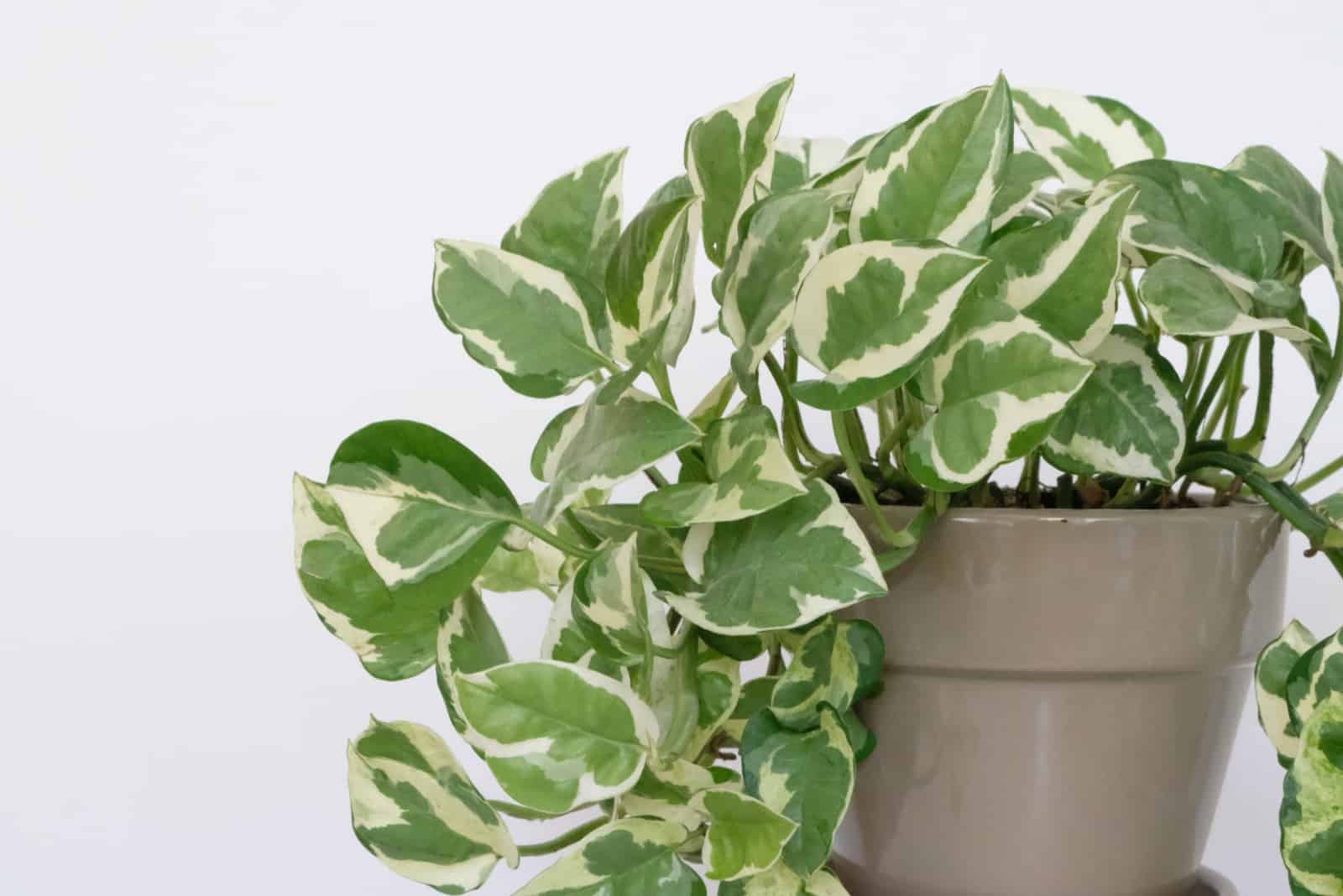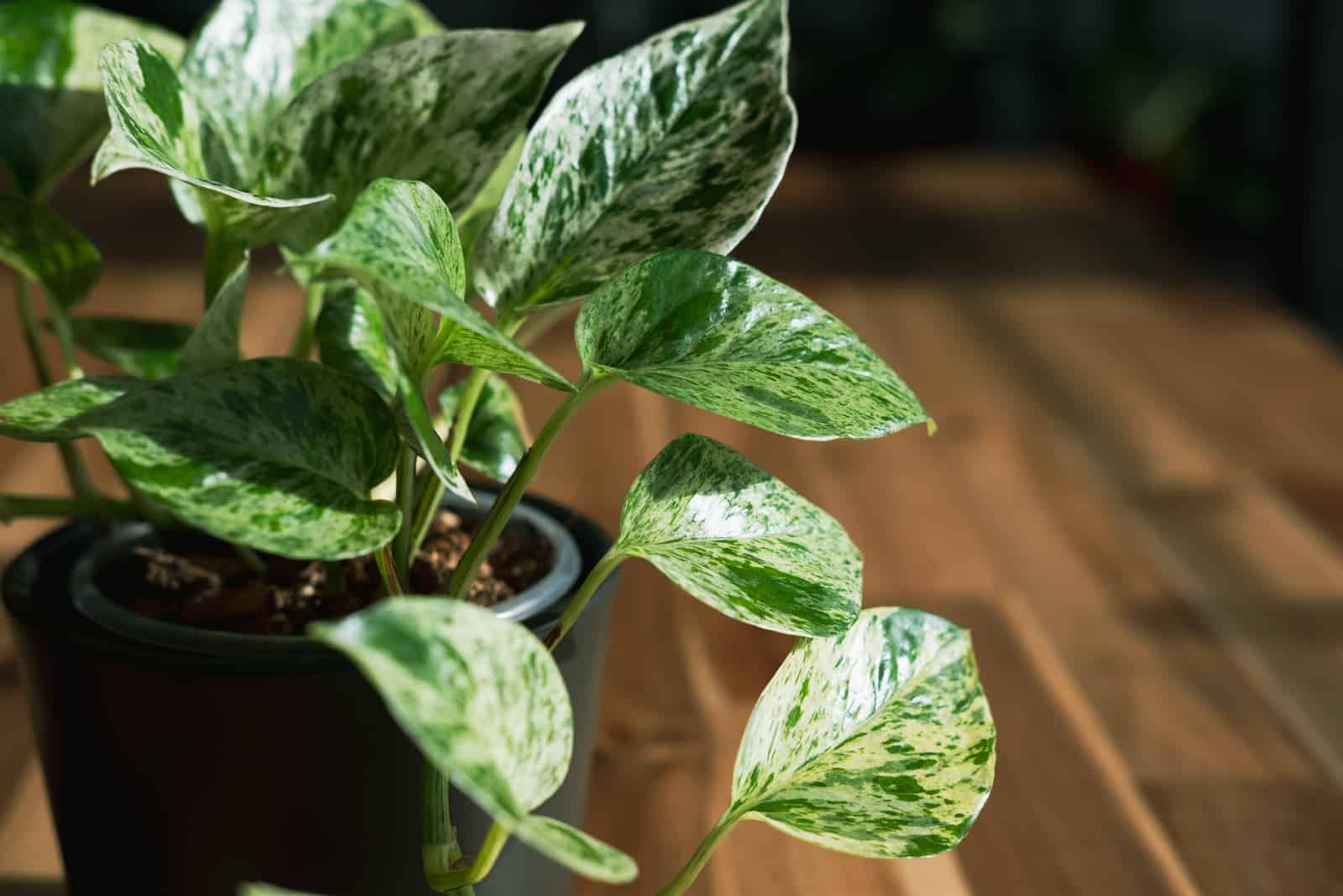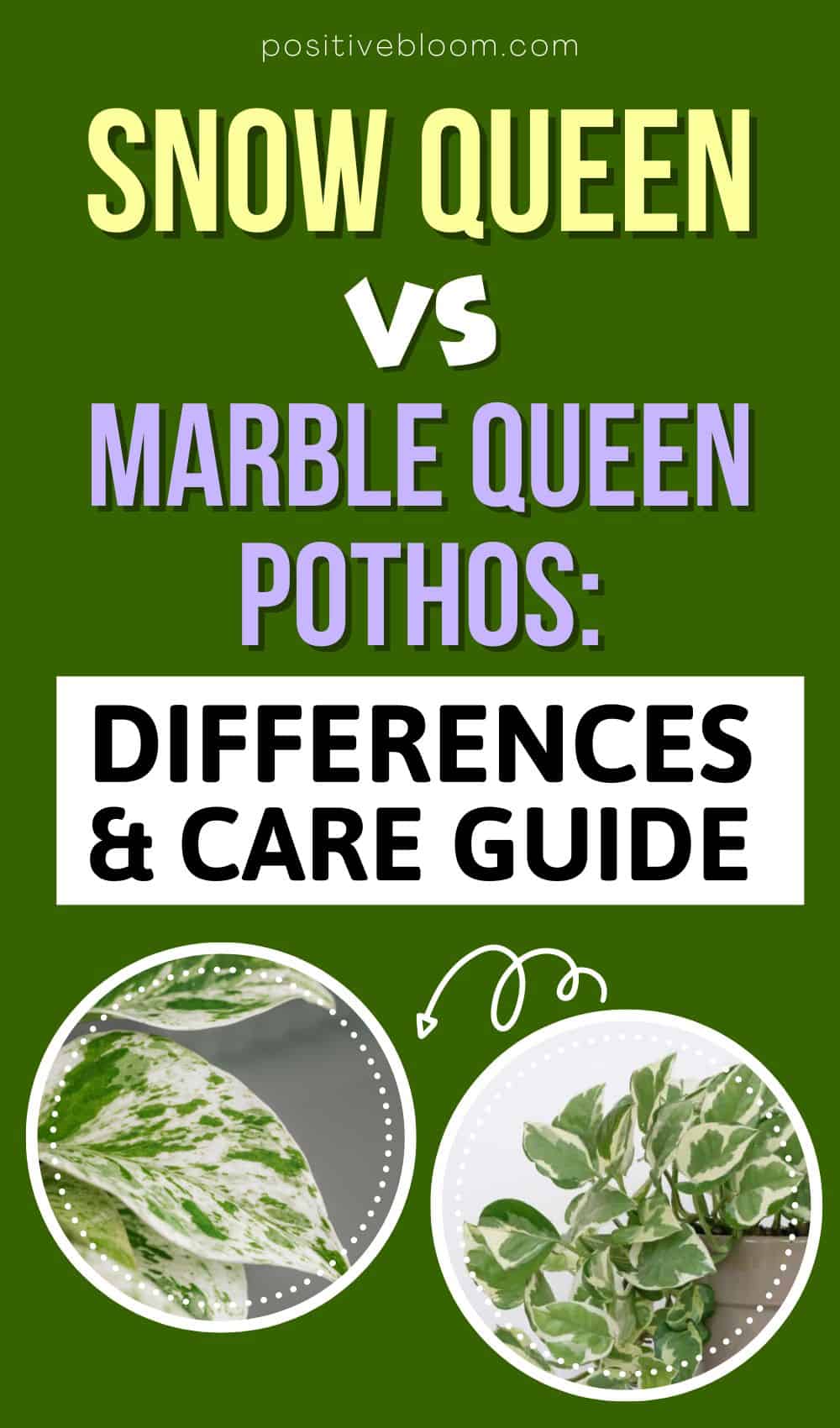People often confuse the snow queen pothos and marble queen pothos.
This confusion happens because of the taxonomy – all pothos are called Epipremnum aureum, although there are many varieties of pothos plants.
They are also named Epipremnum pinnatum or Scindapsus, but these names refer to pothos as one plant.
You might have heard of Devil’s ivy, Golden Pothos, Silver Vine, Manjula Pothos, or the Neon Pothos… all of these are types of pothos in addition to the previously mentioned queens.
Both queens belong to the royal family Araceae, and are usually cultivated as indoor plants due to the unique variegations on their leaves and their low-maintenance.
The Snow queen pothos and Marble queen pothos look a lot like each other! They both grow heart-shaped leaves with sharp tips.
They can be distinguished if you pay attention to some subtle differences.
It’s kind of like playing spot-the-difference, just with Snow queen vs Marble queen pothos, instead of pictures!
Read on to discover the solutions! 🙂
Snow Queen vs Marble Queen Pothos: The Main Differences
Let’s take a look at the differences between the snow queen and the marble queen.
Leaves
The main difference between these two queens are their leaf colors.
Both plants start off growing similar green leaves. However, as they mature their leaves change as well.
After some time, the Snow queen pothos will have whiter variegations compared to the Marble queen. Also, these white variegations take up much more space on the leaves.
They have a light green color in the background, and the overall leaf is paler, so it’s no wonder they are called Snow queen!
When it comes to the Marble queen pothos, their variegations and green colors usually take up the same amount of space on the leaves.
They have darker green colors and their variegations vary from a white color to creamy. They bear a resemblance to marble, which is why they are called Marble queens.
Both have similar leaf shapes, with Snow queen pothos having more pointy tips than the Marble queen pothos.
The leaf texture is also the same, they appear more waxy with slight protuberances on the surface.
Growth habits
If you remember biology from high-school, you know that chlorophyll is a pigment that gives green color to the leaves.
So, if the Snow queen pothos has much more white variegation than green color on its leaves, we can conclude that it contains much less chlorophyll compared to the Marble queen pothos leaves, which are mostly green.
Chlorophyll contributes to growth, therefore the plant that contains more chlorophyll will grow more vigorously than the other.
This is why the Marble queen will grow much quicker, and also why it needs more nutrients compared to the Snow queen.
Both of these houseplants are climbers that can reach almost the same height. You can get creative and provide them with something to grab on to since they are both trailing varieties.
This way you can create a little jungle in your room!
Their growth actually depends a lot on the conditions you provide them – if you plant them in smaller pots, they will adapt to their environment and grow according to it.
If you want them to grow bigger, you should provide them with space and plant them in larger pots. It works fine both ways!
Petioles
The petioles of these two plants are also quite similar, although for one they are whiter.
Can you guess which one?
If you chose Snow queen pothos, you are totally right!
The Snow queen produces whiter petioles compared to the Marble queen.
Pothos care differences
Although these plants are practically the same species, they have different requirements for growth and development.
Soil
We previously mentioned that they differ in growth rate, which is the reason they have different soil requirements.
For instance, Marble queen pothos grow more vigorously and require larger pots as their roots develop faster.
You can use a pot that is 8 inches wide and deep. For the Snow queen, it can be 6 inches.
Additionally, the Marble queen requires soil that contains more nutrients because plants need energy for growth.
Light
Light requirements influence the level of variegation.
If you want your Snow queen pothos to be more variegated, you should provide it with more indirect light.
An interesting thing is that if you put your Snow queen somewhere with low light, it will have less variegated and darker leaves, which will lead to faster growth.
And you can probably assume why this happens.
Because of chlorophyll of course!
The Marble queen pothos will have beautiful variegated leaves if provided with enough light. Also, this plant will require more light than the Snow queen pothos.
Watering
The same thing applies to watering habits as well.
You should water the Marble queen pothos more frequently than the Snow queen as it is a faster grower.
Fertilizer
Fertilizers are food for plants. Which one of these plants do you think needs more food?
The Marble queen pothos again!
This little queen needs energy to grow up big and strong with magnificent leaves!
For the Snow queen pothos, get a slow-release fertilizer and use a small amount at the beginning of the growing season.
If you want your Snow queen to be healthy and happy, don’t skimp when buying organic fertilizers like worm castings.
Diseases
Snow queen pothos are more susceptible to disease because they have less chlorophyll. Unfortunately, this snow queen cannot freeze anything.
If it could, then it would definitely freeze fungal spores because they cause fungal diseases in plants.
Brown spots on the leaves are an indicator of fungal infections.
To prevent this, you should provide your Snow queen pothos or Marble queen pothos with enough sunlight and good air circulation. Don’t ever overwater this plant!
If your plant gets infected, you can spray fungicide on the brown spots to get rid of those little spores.
Pothos Plant Care Guide
It is common that members of the same family have similar requirements, and both Snow queen pothos and Marble queen pothos plants are members of the same family.
If you have recently bought a new pothos plant, you should read the plant care guide below to learn how to make your plant happy!
Soil
Pothos plants prefer well-draining soil so they can avoid retaining too much moisture. Retaining too much water leads to root rot, so choosing the correct soil is very important.
The perfect soil mix and drainage holes on the bottom of the pot will help remove excess water.
You can either buy aroid potting mix or make some of your own!
If you want to make the best potting mix, you should use perlite, universal soil mix, and peat moss. You can also use this mixture to grow philodendrons.
Light
When it comes to light conditions, pothos thrive in indirect sunlight!
You can place your new houseplant on a window that doesn’t get direct sunlight, or in hanging baskets near the windows.
It’s important to avoid direct sunlight because the variegations on the leaves can completely fade, which would be tragic as the leaves are the most important part of this decorative houseplant.
Watering
Pothos plants should be watered more frequently (once a week) during their growing season, which is in summer.
However, during the colder period they should only be watered once every two weeks.
You should know that pothos do not enjoy soggy soil as it can lead to root rot. It is very important to avoid overwatering!
When it comes to watering, the best approach would be to check if the soil has completely dried before watering it again. You can do this by using your thumb or wooden chopsticks.
Temperature
Pothos are tropical plants, so they enjoy constant warm temperatures.
If you have any type of pothos plant, then you should know that they prefer temperatures from 18 to 23 degrees Celsius.
Any lower temperature would harm your pothos, and any higher would be too hot for it to handle.
Fertilizers
Some say that pothos do not need any fertilizers whatsoever.
In my opinion, a little plant food shouldn’t do this plant any harm.
Pothos should be fertilized frequently during their growing season, then you can take a break during the colder seasons.
You can use either slow-release or liquid fertilizers, it all depends on the pothos variety in question.
Propagation
These pothos are common houseplants because they are so easy to propagate and take care of.
If you want to propagate your pothos, first cut off part of a healthy stem. The cutting should contain at least four leaves and nodes.
You can put the cutting in either soil or water.
If you choose soil, the nodes should be buried in the soil. Keep the soil slightly moist.
In water, you can actually see the new growth of roots. As soon as you see the new roots, immediately transfer the plant to the soil so it can adapt to its new environment.
In case that you need a video to follow all steps, you can check out this one that uses two different methods:
Frequently Asked Questions
1. Is the Snow queen pothos endangered?
No, it isn’t. The Snow queen pothos is a common houseplant that is easy to propagate, so it isn’t in any danger of extinction.
2. What is the rarest pothos?
The rarest pothos is the Harlequin pothos, which actually looks like a combination of the Snow and Marble queens we’ve been discussing thus far. This pothos has dark green leaves with beautiful white variegations, and the contrast of these colors is an excellent representation of nature’s art.
3. Are pothos toxic?
Unfortunately, yes. They contain toxic chemicals that can cause vomiting and nausea if ingested. Keep children and pets away from any pothos variety!
If you are interested in knowing more about what houseplants are toxic and air purifying at the same time, follow this link.
4. What is the most popular pothos?
The Golden pothos is the most popular among all the pothos varieties. It is believed that the Golden pothos is a lucky plant that can attract money and good luck, and the heart-shaped leaves are truly beautiful and decorative.
Final Thoughts
Pothos are common decorative houseplants that are easy to take care of. There are different varieties of pothos, though you can apply the same plant care guide to any of them.
The Main difference between pothos varieties is the leaves variegation.
When it comes to the comparison of Snow queen vs Marble queen pothos, the Snow queen pothoss has slightly whiter leaves.
So, if you are looking for a whiter plant that fits better with the rest of your room decor, then you should definitely get a Snow queen pothos.
If you want something marbled in your room, and aren’t sure what, I would suggest you get the Marble queen pothos because it’s both easy to take care of and will also bring a tropical vibe to your room.
I hope this article was helpful, until next time!
Like this post? Share or pin it for later!

